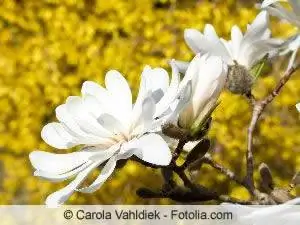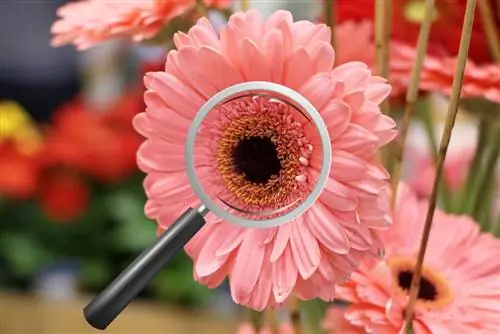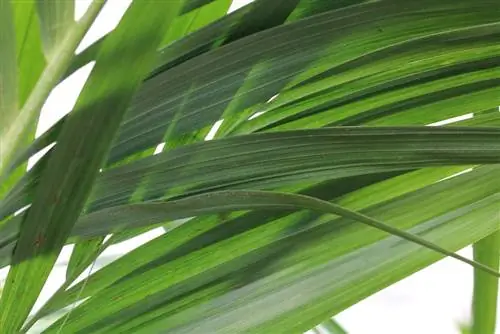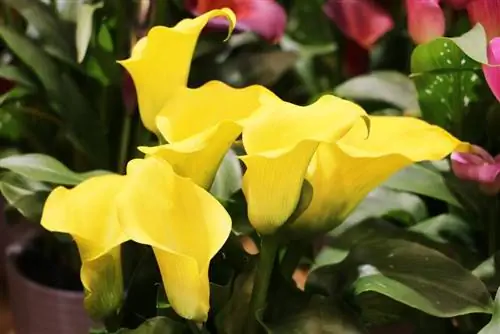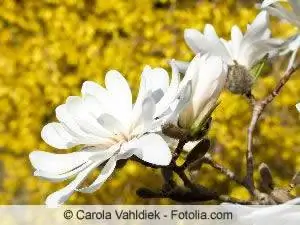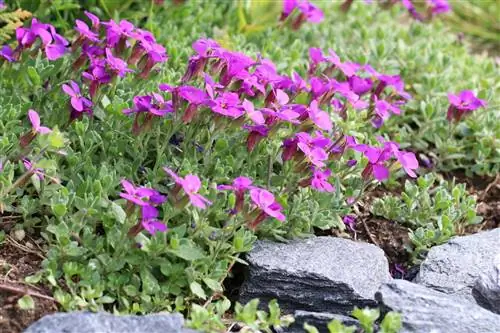- Author admin [email protected].
- Public 2023-12-17 03:39.
- Last modified 2025-06-01 06:48.
Garden and house plants with exotic origins or unusual looks are popular living decorations. Especially in the garden, they are often exposed to unfamiliar and unfavorable influences and therefore require special protection. Therefore, when selecting, care must be taken as to whether the plants are suitable for the local climate and how they need to be overwintered. This point is not only crucial for plants for the garden, overwintering can also mean a significant amount of additional work for houseplants.
Notes for exotic garden plants
Exotic garden plants - whether from Asia, America or the Mediterranean - need one thing above all: protection. The location should therefore be chosen carefully. As a rule, it needs to be warm and protected from wind and rain. These properties are particularly important in winter, when frost and winter sun cause problems for the plants. In addition to the location, the substrate is crucial. The soil must urgently be adapted to the exotic garden plant so that it can thrive. This is sometimes difficult when planted freely in the garden, as sooner or later, even with a large excavation, washing out and mixing occurs. This is particularly problematic with regard to the pH value - but can be avoided by cultivating in a container or making careful selection. Last but not least, winter must be taken into account. If you choose an exotic garden plant, you should note that it must either be overwintered indoors or appropriately protected outdoors. There are only a few exceptions to this rule and only when the winters are mild. In most cases, the decision for exotics means more effort and should be carefully considered for this reason and the possible increased space requirements.
Popular varieties
Cultivating exotic plants in the garden can be difficult, but with the right selection it is certainly not impossible. Suitable examples are:
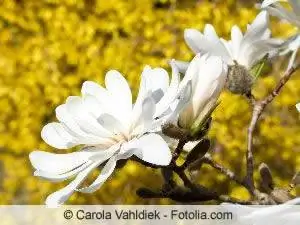
Agave
Dry and sandy soil that allows water to drain quickly and a sunny location with protection from wind and cold - the agave is happy. Nevertheless, the appearance of the thick-fleshed plant is anything but boring or ordinary. The unusual plant only needs some protection in longer and harsher winters. Alternatively, it can be grown in a bucket, at least initially.
Bamboo
Bamboo simply cannot be missing in the exotic Asian garden. The thin to impressively thick stems grow incredibly quickly, can serve as a privacy screen and become a backdrop for decorations. In addition, the bamboo requires very little care, but it does require the right location.
Prickly Pear Cactus
The roots of the prickly pear cactus want it to be dry and permeable, then the unusual plant usually thrives without any problems and without much effort. In the beginning, however, it is advisable to overwinter indoors because the young plants are hardly winter hardy and are quickly damaged in the cold season.
Kiwi
The climbing kiwi can stand alone or be planted in groups to bear fruit. In any case, it needs climbing aid to thrive and develop its full beauty. In any case, it is an exotic species in the home garden.
Magnolia
Winter-hardy magnolia species are now increasingly available in stores. And to the delight of hobby gardeners. The lushly blooming plants are real eye-catchers in the garden and don't even require any complex or unusual care.
Yucca
Better known as a houseplant, new cultivars of the Yucca palm are now also hardy in this country. They are therefore ideal for the palm garden or the exotic corner of your own green space. However, young Yuccas should still be overwintered indoors and should first be cultivated in a bucket.
Demands and special features of the unusual species
Due to the generally fairly consistent temperatures and the easier-to-control conditions, it is much easier to cultivate exotic plants as houseplants. Exotic plants such as orchids or cacti are therefore very popular. Not least because they are easy to maintain. However, they also have special requirements that need to be taken into account. This includes taking air humidity into account. Desert plants, such as succulents, also thrive in dry, heated air. The same applies to significant temperature fluctuations between day and night in rooms that are only heated temporarily. Tropical plants, such as numerous types of orchids, require high humidity and consistent temperatures. The bathroom and kitchen or an indoor greenhouse are therefore the better locations for them. Apart from that, many exotic plants can be cultivated in the same way, so they do not require a separate location for overwintering and do not require any changes in care. Here too, there are differences that should be taken into account when making the purchase decision.
Suitable exotics for the room
The following are suitable and sometimes already popular exotic houseplants:
Aloe
Moist in summer, dry in winter but always in loose soil - the aloe or, more precisely, real aloe vera has few requirements and is the ideal houseplant. It's not just decorative - its thick-fleshed and slightly toothed leaves can also be easily cut off and used to treat wounds in the event of insect bites, burns or other injuries. In summer, the succulents can also be placed outdoors. However, they do not require separate wintering.
Avocado
The avocado is well known as an ingredient in salads and on sandwiches - but as a houseplant it is still underestimated. The plant is quite easy to care for and does not require any special overwintering; instead, it can stay in normal room temperatures all year round.
Elephant foot
Testudinaria or elephant's foot, this plant is visually unparalleled. Originally from South Africa, the rhythm is a bit unusual. Peace in the summer, growth in the winter - a topsy-turvy world. The plant is watered abundantly and well fertilized in the cool season, but in summer it should only be given an occasional sip of water. The interestingly growing elephant foot with its thick and furrowed tuber survives the holiday without any problems.
Candlestick Flower
The candlestick flower is an extremely undemanding houseplant that is best cultivated in hanging baskets or with an appropriate climbing aid. Humid or dry, 10 or 24°C - the candlestick flower is anything but picky and adapts quickly.
Mango
Grown yourself or bought - the mango is an unusual and, above all, rare ornamental that is still hardly known as a plant. If it gets enough sun, it is also surprisingly easy to care for as a houseplant and is ideal even for beginners.
Orchid
The amount of care required for orchids depends solely on the species. The well-known and popular Phalaenopsis, for example, does not require much work, but when cultivated correctly, it blooms breathtakingly beautifully and is even quite easy to propagate. Things look different with the Dendrobium. You should research exactly what is required for successful cultivation in advance.
porcelain flower
The porcelain or wax flower is a real decoration and not just visually. The flowers are beautiful to look at as a hemisphere and also pamper the nose. The lushly growing exotic species doesn't require a lot of effort, quite the opposite.
Zimmeraralie
Little light, little care, fluctuating temperatures and overall poor conditions at the location? None of this is a problem for the indoor aralia. Nevertheless, it grows to an impressive size in a short time and requires little effort. Beginners and hobby gardeners with little time will especially enjoy it.
Room hops
Decorative and colorful ears, all year round - this is what indoor hops offer for a minimum of effort and care. By quickly cutting them into the desired shape, the ornamental hops do not run the risk of becoming too large for the chosen location. This exotic houseplant is an insider tip not only for beer lovers.
Conclusion
If you want to own exotic house and garden plants, you don't always have to put in a lot of effort. There are quite a few plants that impress with their unusual appearance - without requiring a lot of time and work. Only the selection can be a challenge.

